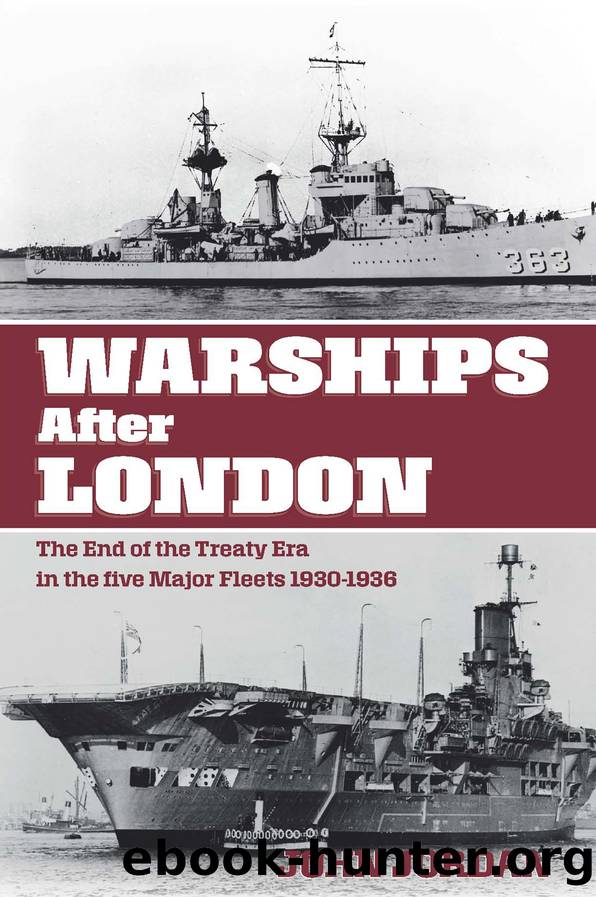Warships After London by John Jordan

Author:John Jordan
Language: eng
Format: epub
Tags: History / Military / Naval
Publisher: Seaforth Publishing
Published: 2020-10-15T00:00:00+00:00
The London Treaty of 1936 and its Impact on the Royal Navy
Most of the negotiation at the London Conference of 1935â36 (for detail see Chapter 8 Postscript), as at the earlier London conference, focused on the cruiser category. It was agreed that future cruisers should be limited to a standard displacement of 8,000 tons, and although the British refused to have a quantitative ceiling imposed, there was to be an informal agreement to the effect that the British would maintain a force of seventy cruisers, of which ten would be over-age, while the US Navy would be permitted to build up to a force of sixty under-age cruisers. Since current projected US force levels were only thirty-seven ships, of which two Omahas were shortly due for replacement,20 this would mean twenty-five new cruisers, which because of the new 8,000-ton limit would necessarily be âfleetâ ships.
The London Treaty of 1936 had minimal impact on the Royal Navyâs plans, which is perhaps unsurprising given that the proposals adopted by the conference were largely those put forward by the British. By this time Britain was becoming increasingly concerned that it might have to fight in two theatres simultaneously, hence its attempt to secure acceptance for a new âtwo-powerâ standard embracing a minimum figure of seventy cruisers.21
In order to attain a force level of seventy ships within the necessary time frame, it would be necessary to at least double the figure of three cruisers laid down per year that had prevailed during the early 1930s, and to retain some of the over-age ships that would otherwise have been scrapped.
The problem with the retention of the over-age ships, particularly the small cruisers of the âCâ and âDâ classes completed during the latter part of the First World War,22 was that they were no longer regarded as suitable for fleet work due to their relatively low speed and obsolescent armament. In their place the Royal Navy wanted to build modern units capable of matching the French contre-torpilleurs and the Italian âCondottieriâ in performance, so during late 1934 seven small cruiser designs were drawn up with a view to providing a âCâ/âDâ replacement. All except two of these designs were in the 4,500â5,500 displacement range (ie comparable to the âCâs and âDâs), with moderate protection, a speed of 31â33 knots and an armament of six 6in guns, generally in single mountings.23 The sixth was a small unprotected cruiser of 3,500 tons, with âdestroyerâ machinery capable of 38 knots, and there was also an attempt at an 1,850-ton ship, designated the Scout âVâ, which was intended as a counter to the French and Japanese âleadersâ (in fact the contretorpilleurs and âSpecial Typeâ destroyers respectively); the latter was to be armed with five twin 4.7in guns, and would provide the basis for the destroyers of the âTribalâ class (see Chapter 5). All of the larger ships had protection adequate to take on other 6in cruisers, and there was an emphasis on anti-aircraft capabilities at the expense of aviation facilities, long-range reconnaissance being the function of the carrier(s) accompanying the fleet.
Download
This site does not store any files on its server. We only index and link to content provided by other sites. Please contact the content providers to delete copyright contents if any and email us, we'll remove relevant links or contents immediately.
| Automotive | Engineering |
| Transportation |
Whiskies Galore by Ian Buxton(41937)
Introduction to Aircraft Design (Cambridge Aerospace Series) by John P. Fielding(33092)
Small Unmanned Fixed-wing Aircraft Design by Andrew J. Keane Andras Sobester James P. Scanlan & András Sóbester & James P. Scanlan(32763)
Craft Beer for the Homebrewer by Michael Agnew(18195)
Turbulence by E. J. Noyes(7977)
The Complete Stick Figure Physics Tutorials by Allen Sarah(7336)
Kaplan MCAT General Chemistry Review by Kaplan(6899)
The Thirst by Nesbo Jo(6877)
Bad Blood by John Carreyrou(6581)
Modelling of Convective Heat and Mass Transfer in Rotating Flows by Igor V. Shevchuk(6406)
Learning SQL by Alan Beaulieu(6237)
Weapons of Math Destruction by Cathy O'Neil(6214)
Man-made Catastrophes and Risk Information Concealment by Dmitry Chernov & Didier Sornette(5952)
Digital Minimalism by Cal Newport;(5702)
Life 3.0: Being Human in the Age of Artificial Intelligence by Tegmark Max(5510)
iGen by Jean M. Twenge(5384)
Secrets of Antigravity Propulsion: Tesla, UFOs, and Classified Aerospace Technology by Ph.D. Paul A. Laviolette(5332)
Design of Trajectory Optimization Approach for Space Maneuver Vehicle Skip Entry Problems by Runqi Chai & Al Savvaris & Antonios Tsourdos & Senchun Chai(5037)
Pale Blue Dot by Carl Sagan(4952)
